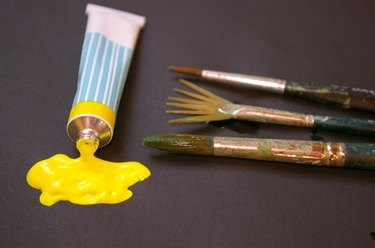
According to the International Expressive Arts Therapy Association, expressive art therapists use multimodal arts processes to transform and help individuals, groups and communities. Expressive art activities allow participants to share feelings more openly with therapists or facilitators. Activities can be simple drawings to warm up a tough crowd, or more elaborate activities in a one-on-one setting.
Puppets
Video of the Day
When children or teenagers in therapy groups have a hard time opening up and sharing with each other, Poppy K. Moon, licensed counselor and author of "Reaching the Tough Adolescent through Expressive Arts Therapy Groups," recommends creating puppets. Though older children might find this childish at first, encourage them to be creative with their puppets, and allow them to make any kind of puppet they would like. The facilitator should also provide embellishments for the puppets so that children can personalize them as they choose. Some embellishments could include fabric for hats and clothes, thread for hair and even pipe cleaners for glasses.
Video of the Day
Bag Self-Portrait
Moon suggests using brown paper bags to help students get to know each other and tell a little about themselves. Give the group participants the paper bags, and ask them to draw a self-portrait on one side of the bag. Provide enough supplies, such as crayons, markers, stickers and fabric, so that the members can personalize their self-portraits. After they finish their self-portrait, ask members to list their fears on one side of the bag and their hopes on the other. On the back of the bag, have them create their tombstone or write a eulogy that tells others for what they hope to be remembered. Inside the bag, ask participants to place items that make them who they are, such as their favorite books, CDs or maybe even pictures of people who are important to them.
Body Image Sketch
Those who are in therapy for self-esteem or eating disorder problems can create expressive art to demonstrate how they feel about themselves. The participant should draw a self-portrait. This can be as simple as a stick figure or a more elaborate drawing, depending on the artist's abilities and willingness to participate. The artist and the therapist should discuss what the artist sees. Is the drawing an accurate resemblance of the person? The artist should write on the drawing areas of concern. What areas does she feel are problems? What would she change if she could? After the artist has time to write down her thoughts about the drawing, discuss her expectations of her herself.